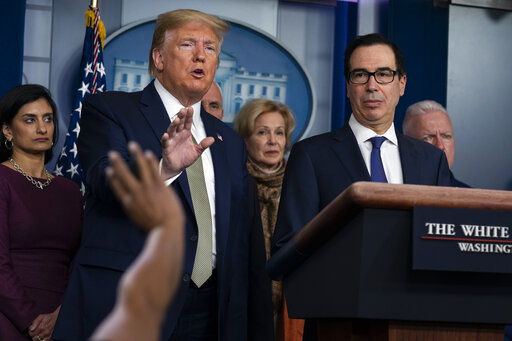



A sign for EvergreenHealth Medical Center is shown on March 17, 2020, in Kirkland, Washington. (AP/Warren)
Experts said all evidence points to the U.S. being short on hospital beds, ICUs and ventilators, assuming COVID-19 continues to spread.
The U.S. could take any number of actions to increase the number of hospital beds, supplies and medical staff available.
Social distancing and other measures to slow the virus’s spread are meant to shrink the peak number of cases so hospitals don’t get stretched past their capacity.
Fox News talk show host Sean Hannity celebrated the White House’s response to the novel coronavirus in a recent TV monologue, saying the U.S. health care system is ready for the virus.
"We need to prepare for the worst-case scenario," Hannity said on his TV show March 16. "The president and his task force confirmed they are. Now, as it stands, our health care system has adequate ventilators, ICU beds, medical professionals and ultimately, like I said, we must prepare for the worst, pray for the best."
That contradicts the warnings of public health experts, who have been sounding alarm about the shortage of ventilators, intensive care unit beds and medical professionals and encouraging Americans to practice social distancing as a way of preventing hospitals from being overrun.
Hannity is wrong to say the U.S. has everything it will need, experts said. U.S. hospitals might be able to deal with the number of patients today — although experts we spoke to disagreed on whether that was the case — but the situation will likely look different as it evolves.
"We don’t have nearly enough hospital and ICU beds if there is a surge of cases," said Ashish Jha, director of the Harvard Global Health Institute. "There is no basis for his assertion."
"Even a mild surge of COVID patients will stress our ICUs as they have never been stressed before," added Eric Toner, a senior scholar at the Johns Hopkins Center for Health Security.
The available data suggests that U.S. hospitals are not as well-equipped as Hannity claimed.
According to the Organization for Economic Cooperation and Development, the United States has 2.8 hospital beds per 1,000 people. That ratio puts the U.S. behind other countries — such as China and Italy — that have struggled to keep up with the spread of COVID-19.
That doesn’t bode well for the U.S. response to the coronavirus. As of March 16, Italy has seen more than 24,700 confirmed infections and over 1,800 deaths, according to the World Health Organization. Hospitals can’t handle the influx of patients, forcing doctors into difficult decisions.
In a March 12 op-ed in the New York Times, health policy experts wrote that if 5% of the country catches COVID-19, there will be enough serious cases to overwhelm the health care system.
"If we follow the curve that Italy has followed, in two to three weeks we will no longer have adequate supplies of any of those necessary resources," Matthew Wynia, director of the Center for Bioethics and Humanities at the University of Colorado, told us.
A March 17 analysis from the Harvard Global Health Institute, ProPublica and the New York Times shows how many beds would be filled in parts of the United States if, over the next six, 12 or 18 months, the coronavirus infects 20%, 40% or 60% of the country.
The projections show that many U.S. cities won’t have enough hospital beds to meet the number of sick patients in need, assuming the virus continues to spread and nothing is done to increase the hospitals’ capacity. Some states will be worse off than others.
In the worst-case scenario — where 60% of the population gets sick within six months — the U.S. would need seven times the number of available hospital beds it currently has, the analysis found. Even in a moderate scenario where 40% is infected over 12 months, many cities such as Washington, D.C., would still need to significantly expand hospital capacity.
Jha, who worked on that project, told us its findings show Hannity’s claim to be wrong.
The health care system is projected to be overwhelmed by coronavirus patients unless drastic measures are taken. Social distancing and isolation will slow its spread. Here is why that will save lives. pic.twitter.com/R1djQQdpYc
— ProPublica (@propublica) March 17, 2020
Another analysis from USA Today found that "there could be almost six seriously ill patients for every existing hospital bed" — and possibly as many as 17 patients per bed.
That examination said the 6-to-1 ratio was a "conservative" estimate based on the assumption that all the hospital beds in the U.S. are currently empty. They’re not.
"Our ICUs are currently stretched thin by flu, and we have shortages of nurses and doctors in many parts of the country," Toner told us.
A February report Toner worked on at Johns Hopkins said the U.S. has approximately 46,500 ICU beds in total.
If the coronavirus spreads at a moderate pace, then 1 million Americans could be hospitalized and 200,000 Americans would ultimately need an ICU, the report said. A more severe scenario could put up to 9.6 million Americans in the hospital and 2.9 million in need of ICUs.
A separate Johns Hopkins Center for Health Security report identified about 160,000 ventilators in the country, though not all are full-featured. That includes tens of thousands of ventilators in hospitals nationwide and thousands more in an emergency federal stockpile.
But in 2018, the group estimated that a moderate pandemic similar to the 1957 or 1968 influenza viruses would put about 65,000 people in need of ventilation, and a severe pandemic like the 1918 flu would require ventilators for some 742,500 people.
Not all COVID-19 patients will need treatment at the same time, of course. Aaron Carroll, professor at the Indiana School of Medicine, wrote in the New York Times that a key metric is "the difference between the total number of people who might get sick and the number who might get sick at the same time." But states and doctors are worried about shortages.
Social distancing, shutdowns and other preventative measures to slow the spread are meant to shrink the peak number of cases so hospitals don’t get stretched past their capacity.
Together, we can “flatten the curve” by practicing social distancing, staying home when sick, and washing hands often. This will reduce the strain on our hospitals and emergency rooms, and literally save the lives of our most vulnerable residents. #COVIDー19 #NovelCoronavirus pic.twitter.com/6Yzvg3DONv
— LA Public Health (@lapublichealth) March 15, 2020
"That is why hospitals are cancelling all elective surgeries, planning to expand capacity as much as possible, and even getting ready to make very difficult, battlefield-style triage decisions if it comes to that," Wynia said. "There is an enormous storm coming, and our best meteorologists can’t be sure exactly how big it will be, when it makes landfall, or where it might hit hardest."
President Donald Trump has said the federal government has ordered more equipment and instructed governors to purchase supplies directly if they can get them faster on their own.
"We’ve ordered massive numbers of ventilators," Trump said during a March 17 briefing. "By any normal standards, we have a lot of respirators, ventilators."

Treasury Secretary Steven Mnuchin listens as President Donald Trump speaks during a press briefing with the coronavirus task force at the White House in Washington on March 17, 2020. (AP/Vucci)
Trump said the Army Corps of Engineers is "ready, willing and able" to retrofit its facilities and build new field hospitals to care for more patients, saying they could do so "very rapidly."
In the same briefing, Vice President Mike Pence called on construction companies to donate their masks to local hospitals, and Dr. Deborah Birx, a member of the coronavirus task force, said Americans should cancel elective surgeries to "free up hospital beds and space."
New York Gov. Andrew Cuomo said March 18 that Trump has pledged to dispatch a Navy hospital ship to New York Harbor to accommodate patients there.
Hannity said, "Now, as it stands, our health care system has adequate ventilators, ICU beds, medical professionals."
That might be true if the U.S. stopped the coronavirus from spreading any further. But given the country’s likely trajectory, experts said all evidence points to the U.S. being short on beds, ICUs, ventilators and medical professionals.
The U.S. will need to take steps to slow the spread and expand hospital capacity if it wants to keep its health care system from being overrun by the likely uptick in cases.
We rate this statement Mostly False.
Fox News, "Hannity," March 16, 2020
Organization for Economic Cooperation and Development, "Hospital Beds," accessed March 17, 2020
The New York Times, "These Places Could Run Out of Hospital Beds as Coronavirus Spreads," March 17, 2020
ProPublica, "Are Hospitals Near Me Ready for Coronavirus? Here Are Nine Different Scenarios," March 17, 2020
Harvard Global Health Institute, "Caring for COVID-19 Patients and Can Hospitals Around the World Keep Up?" March 17, 2020
C-Span, "President Trump and Coronavirus Task Force Hold Briefing," March 17, 2020
New York Times, "N.Y. May Need 18,000 Ventilators Very Soon. It Is Far Short of That." March 17, 2020
The World Health Organization, "Coronavirus disease 2019 (COVID-19) Situation Report – 56," March 16, 2020
The White House, "Remarks by President Trump, Vice President Pence, and Members of the Coronavirus Task Force in Press Briefing," March 16, 2020
NPR, "As The Pandemic Spreads, Will There Be Enough Ventilators?" March 14, 2020
Vox, "The US needs a lot more hospital beds to prepare for a spike in coronavirus cases," March 14, 2020
USA Today, "US hospitals will run out of beds if coronavirus cases spike," March 13, 2020
Society of Critical Care Medicine, "U.S. ICU Resource Availability for COVID-19," March 13, 2020
The New York Times, "How the Coronavirus May Force Doctors to Decide Who Can Live and Who Dies," March 12, 2020
The New York Times, "Here’s the Biggest Thing to Worry About With Coronavirus," March 12, 2020
Modern Healthcare, "Trump issues executive order to boost respirator mask supply," March 11, 2020
Business Insider, "Hospitals could be overwhelmed with patients and run out of beds and ventilators as the coronavirus pushes the US healthcare system to its limits," March 11, 2020
The Huffington Post, "The Coronavirus Outbreak Is About To Put Hospital Capacity To A Severe Test," March 8, 2020
Johns Hopkins Center for Health Security, "What US Hospitals Should Do Now to Prepare for a COVID-19 Pandemic," Feb. 27, 2020
Johns Hopkins Center for Health Security, "Ventilator Stockpiling and Availability in the US," Feb. 14, 2020
Johns Hopkins Center for Health Security, "Ventilator Stockpiling and Availability in the US and Internationally," May 3, 2018
Cambridge University Press, "Mechanical Ventilators in US Acute Care Hospitals," October 2010
PolitiFact, "To stop coronavirus in its tracks, here’s your guide to 5 degrees of separation," March 16, 2020
PolitiFact, "Fact-checking the Sanders-Biden primary debate," March 15, 2020
Email interview with Eric Toner, senior scholar of internal and emergency medicine at the Johns Hopkins Center for Health Security, March 17, 2020
Email interview with Matthew Wynia, director of the Center for Bioethics and Humanities at the University of Colorado, March 17, 2020
Email interview with Ashish Jha, director of the Harvard Global Health Institute, March 17, 2020
Statement from the Department of Health and Human Services, March 18, 2020
In a world of wild talk and fake news, help us stand up for the facts.
